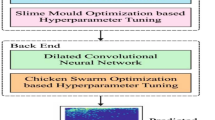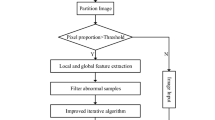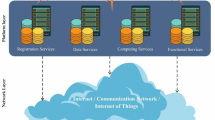Abstract
As a part of smart city schemes, many governments are developed intelligent methods to improve the quality of living by offering them intelligent services to enhance sustainability, livability, and workability. These intelligent methods gathered massive data counts, provide more opportunities for governments for analysing these data, and create data-driven decisions. Video surveillance in smart cities offers efficacy in city activities, safe society, and enhanced municipal services. Crowd density analysis is a most commonly used applications of object recognition, but crowd density classifying approaches face difficulties including non-uniform density, inter-scene deviation, intra-scene deviation, and occlusion. Therefore, this study develops an Intelligent Crowd Density Classification using Improved Metaheuristics with Transfer Learning (ICDC-IMTL) model on smart cities. In the presented ICDC-IMTL technique, the major aim is to recognize various kinds of crowd densities efficiently. To achieve this, the ICDC-IMTL technique makes use of the Guided filtering (GF) approach to preprocess the input images. The ICDC-IMTL algorithm exploits a neural architectural search network (NASNet) model and the hyperparameter tuning process is done by the improved artificial flora algorithm (IAFA) for feature extraction purposes. At last, the multilayer extreme learning machine (MLELM) model is applied for the crowd classification into distinct types. The stimulation validation of the ICDC-IMTL approach takes place on a crowd dataset comprising four distinct classes. The series of experiments highlighted the betterment of ICDC-IMTL algorithm over other existing DL technique.










Similar content being viewed by others
Data Availability
The dataset used for the findings will be shared by the corresponding author upon request.
References
Bhuiyan M, Roman J, Abdullah N, Hashim FA, Farid. Mohammad Ahsanul Haque, Jia Uddin, Wan Noorshahida Mohd Isa, Mohd Nizam Husen, and Norra Abdullah. A deep crowd density classification model for Hajj pilgrimage using fully convolutional neural network. PeerJ Comput Sci. 2022;8:e895.
Xiang J, Liu N. Crowd density estimation method using deep learning for passenger flow detection system in exhibition center. Sci Program. 2022;2022:1–9.
Teoh SK, Yap VV, Nisar H. Computer vision and machine learning approaches on crowd density estimation: A review. In AIP Conference Proceedings (Vol. 2654, No. 1, p. 030009). 2023, AIP Publishing LLC.
Li B, Huang H, Zhang A, Liu P, Liu C. Approaches on crowd counting and density estimation: a review. Pattern Anal Appl. 2021;24:853–74.
Wang S, Pu Z, Li Q, Guo Y, Li M. Edge computing-enabled crowd density estimation based on lightweight convolutional neural network. In 2021 IEEE International Smart Cities Conference (ISC2), pp. 1–7, IEEE, 2021.
Fan Z, Zhang H, Zhang Z, Lu G, Zhang Y, Wang Y. A survey of crowd counting and density estimation based on convolutional neural network. Neurocomputing. 2022;472:224–51.
Li YC, Jia RS, Hu YX, Han DN, Sun HM. Crowd density estimation based on multi scale features fusion network with reverse attention mechanism. Appl Intell. 2022;52(11):13097–113.
Zhang X, Sun Y, Li Q, Li X, Shi X. p.56, Crowd Density Estimation and Mapping Method based on Surveillance Video and GIS. ISPRS Int J Geo-Information, 12(2), 2023.
Muthunagai SU, Girija MS, Iyswarya R, Poorani S, Anitha R. Crowd density estimation using neural network for COVID-19 and future pandemics. In: Kanagachidambaresan GR, Bhatia D, Kumar D, Mishra A, editors. System design for epidemics using machine learning and deep learning. Signals and communication technology. Springer, Cham. 2023. https://doi.org/10.1007/978-3-031-19752-9_15
Woźniak M, Siłka J, Wieczorek M. Deep learning based crowd counting model for drone assisted systems. In Proceedings of the 4th ACM MobiCom Workshop on Drone Assisted Wireless Communications for 5G and Beyond, pp. 31–36, 2021.
Alashban A, Alsadan A, Alhussainan NF, Ouni R. Single convolutional neural network with three layers Model for Crowd Density Estimation. IEEE Access. 2022;10:63823–33.
Vikram A, Jothi A, Ahmad S, Rubini LJ, Kadry S, Kim J. Deep learning based vehicle detection and counting System for Intelligent Transportation. Comput Syst Sci Eng. 2024;48(1):115–30.
Rezaee K, Rezakhani SM, Khosravi MR, Moghimi MK. A survey on deep learning-based real-time crowd anomaly detection for secure distributed video surveillance. Pers Ubiquit Comput. 2024;28:135–51. https://doi.org/10.1007/s00779-021-01586-5
Bouhlel F, Mliki H, Hammami M. Abnormal crowd density estimation in aerial images based on the deep and handcrafted features fusion. Expert Syst Appl. 2021;173:114656.
Jia D, Zhang C, Zhang B. Crowd density classification method based on pixels and texture features. Mach Vis Appl. 2021;32:1–22.
Bhuiyan R, Abdullah J, Hashim N, Farid A, Isa FM, Uddin WN, J. and, Abdullah N. Deep dilated Convolutional Neural Network for Crowd Density Image Classification with dataset augmentation for Hajj Pilgrimage. Sensors. 2022;22(14):5102.
Patwal A, Diwakar M, Tripathi V, Singh P. Crowd counting analysis using deep learning: a critical review. Procedia Comput Sci. 2023;218:2448–58.
Salehi H, Vahidi J, Abdeljawad T, Khan A, Rad SYB. A SAR image despeckling method based on an extended adaptive Wiener filter and extended guided filter. Remote Sens. 2020;12(15):2371.
Al-Ghamdi AS, Ragab M, AlGhamdi SA, Asseri AH, Mansour RF, Koundal D. Detection of dental diseases through X-Ray images using neural search architecture network. Comput Intell Neurosci. 2022;(1):3500552.
Nagaraj P, Deepalakshmi P, Mansour RF, Almazroa A. Artificial flora algorithm-based feature selection with gradient boosted tree model for diabetes classification. Diabetes Metabolic Syndrome Obesity: Targets Therapy. 2021;14:2789.
Lama RK, Kim JI, Kwon GR. Classification of Alzheimer’s disease based on core-large scale brain network using multilayer extreme learning machine. Mathematics, 10(12), p.1967, 2022.
Parveen S, Sultan A, Khan MA. Integration of Identity Governance and Management Framework within universities for Privileged users. Int J Adv Comput Sci Appl. 2021;12(6).
Al Duhayyim M, Alabdulkreem E, Tarmissi K, Aljebreen M, El Khier BSIA, Zamani AS, Yaseen I, Eldesouki I. Aquila Optimization with Transfer Learning Based Crowd Density Analysis for sustainable Smart cities. Appl Sci. 2022;12:11187.
Acknowledgements
The author extends his appreciation to Prince Sattam Bin Abdulaziz University for funding this research work through the project number (PSAU/2023/01/25497).
Funding
The authors extend their appreciation to Prince Sattam Bin Abdulaziz University for funding this research work through the project number (PSAU/2023/01/25497).
Author information
Authors and Affiliations
Contributions
Author contributed to design and development of the system as well as the manuscript. Author has read and approved the final manuscript.
Corresponding author
Ethics declarations
Ethical Approval
This article does not contain any studies with human participants or animals performed by any of the author.
Conflict of Interest
The author declares that the research was conducted in the absence of any commercial or financial relationships that could be construed as a potential conflict of interest.
Additional information
Publisher’s Note
Springer Nature remains neutral with regard to jurisdictional claims in published maps and institutional affiliations.
Rights and permissions
Springer Nature or its licensor (e.g. a society or other partner) holds exclusive rights to this article under a publishing agreement with the author(s) or other rightsholder(s); author self-archiving of the accepted manuscript version of this article is solely governed by the terms of such publishing agreement and applicable law.
About this article
Cite this article
Ahmad, S. Intelligent Crowd Density Classification Using Improved Metaheuristics with Transfer Learning Model on Smart Cities. SN COMPUT. SCI. 5, 1064 (2024). https://doi.org/10.1007/s42979-024-03435-7
Received:
Accepted:
Published:
DOI: https://doi.org/10.1007/s42979-024-03435-7




